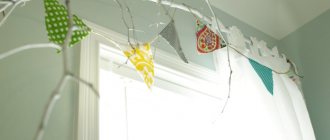Interest in the complex, mysterious and somewhat frightening culture of Japan has not waned for the second decade. A huge treasure trove of rich history and cultural heritage is diverse and inspiring, and the desire to understand the complex Japanese soul leads to attempts to understand their aesthetics, and specifically, the design traditions of Japanese style in the interior.
The traditions of room decoration, honed over centuries, have led to the creation of one of the most stunning interiors in its discreet splendor, where there is nothing superfluous, and every thing has the deepest poetic meaning. After all, in essence, a Japanese-style bedroom is a continuation of harmonious nature; they treat the creation of interiors in the same way as growing plants - everything should be simple, functional, beautiful.
The ideas of minimalism, intertwined with the highest understanding of beauty, give birth to a bedroom interior filled with air, but devoid of simplicity and asceticism. The closeness to nature dictates the materials used in the houses - only natural wood and textiles.
general principles
There are several rules that, in fact, make the bedroom interior similar to Japanese. Yes, yes, exactly like this, since it is beyond our power the Japanese bedroom However, this is understandable: our climate is not the same, and the principles of creating a home are completely different than in Japan. However, making the interior recognizably Japanese is within our competence and capabilities.
Minimalism. The first rule of Japanese interior is minimalism in the objects filling the room. This means that items should not be bulky, there should be nothing superfluous, but everything necessary should be present. Fulfillment of this rule ensures the movement of positive energy flows necessary from the Japanese point of view. This is what distinguishes stylish Japanese-style interiors, popular all over the world.
Japanese minimalism
Functionality. The second rule of Japanese interiors is functionality. It is a kind of continuation of the first rule. In the bedroom of a Japanese home there is supposed to be a chest to put away a futon (folding mattress for sleeping) for the day, a sufficient number of lighting fixtures, and a closet for necessary things.
Close to nature. The third rule of Japanese interiors is the presence of exclusively natural materials. This also applies to finishing materials, textiles, and furniture.
Mobility. The fourth rule is the ability to quickly and easily transform a room. This is due to the fact that homes in Japan are small in size, and a Japanese bedroom, if necessary, can easily be converted into a living room or dining room.
How to decorate the floor, walls, ceiling
The floor of a Japanese-style bedroom is usually made of wood, laminate (including bamboo) or parquet. Finishing the floor with ceramic tiles or marble is also suitable. Traditionally, Japanese homes have special hard mats - tatami, woven from reeds and rice straw. The disadvantage of this coating is the need to replace it quite often (every six months to two years). In modern Japanese bedroom interiors, as a rule, there is no carpet. As an alternative, you can place a rug in a neutral shade on the floor or lay out a small rug with a Japanese-style pattern.
The walls of a Japanese-style bedroom are decorated using one or two tones. In traditional Japanese homes, the walls are equipped with sliding partitions (shoji), consisting of wooden frames and rice paper. In the interior of the bedroom, you can use wallpaper made of bamboo, as well as with a stylized Japanese pattern or ornament, to decorate the walls. You can cover them with wooden panels that imitate sliding partitions. Walls covered with plain natural fabric will also look quite organic. If desired, it is easy to zone a room using screens or partitions - such a room can be turned into a living room or dining room with the help of a simple rearrangement, and then again into a bedroom. This transformation of the room is characteristic of the Japanese style and is very convenient, and is also suitable for small rooms.
You should carefully select the combination of colors of the floor and walls, keeping them in similar colors - and it is recommended that the color of the flooring be one or two shades lighter. For example, a gray floor will suit white walls, and a sand-colored floor will look great against beige curtains.
The Japanese-style bedroom ceiling traditionally creates a feeling of lightness and unpretentiousness. Its matte surface, usually in light colors, is designed in the same color scheme as the walls (for these purposes, you can equip a suspended ceiling or a suspended ceiling with square sections, equipped with built-in lighting made of frosted glass).
desired color schemes
In a Japanese-style bedroom, variegated, poisonous colors are unacceptable. The color scheme should be calm, discreet, and natural. White, beige, cream, and gray shades are in demand; black is quite acceptable, but only as an additional one, in combination with the main one.
The color of mahogany and rich chocolate shades are considered especially undesirable. But this is if we talk about the Japanese bedroom itself. In stylizations, any colors that are pleasing to the owners of the bedroom are appropriate. The main thing is to avoid excessive variegation, flashiness, and brightness.
To decorate a Japanese-style bedroom interior, one of the selected colors is chosen, and all details - decoration, furniture, curtains - are maintained in shades of the selected color.
For color and aesthetic harmony, several contrasting accents are made in the decor, shading and emphasizing the main tone.
Interior decoration
The interior of a Japanese-style bedroom, like any other, requires intimacy in space. The main assistants in this matter are curtains or drapes. Curtains made of natural cotton or silk will fit perfectly into a Japanese interior; they should simply be a strip of fabric without folds, fringes or other decorative excesses.
Japanese style bedroom design does not accept many accessories. If they are present, they must be concise and expressive. You can put a couple of traditional Japanese figurines in the niches. Decorate the walls with parchments with Japanese calligraphy or with a sakura sprig.
Bonsai should be used as indoor plants. It is a dwarf tree growing in a small pot. A glass vase with sprigs of dried or live bamboo will also look good.
A bedroom in this style will be perfectly complemented by candles and aromatic lamps, plates with dried flower petals in them. These little things will give the space a Japanese flavor, but at the same time they will not clutter it up.
The interior of a Japanese-style bedroom is a modest, almost empty space. It is decorated in muted colors and has a minimum of furniture and additional accessories. In this room, energy will circulate freely and charge the owners of the room with strength and positive emotions.
Japanese style bedroom: decoration
The floor in a Japanese-style bedroom should preferably be made of wood. Although you can, of course, simply imitate it by using bamboo laminate as a floor covering. If you have the opportunity, and most importantly, the desire, lay a mat on the floor (by the way, in Japanese this kind of carpet is called tatami). But do not forget that it needs to be replaced with a new one every six months.
The interior of a real Japanese house
The walls of a Japanese home are sliding screens with wooden frames covered with rice paper. In our conditions, you can replace them with wooden panels, wallpaper imitating bamboo or stylized as a Japanese traditional ornament or design. Or you can cover the walls with fabric, but certainly natural and preferably monochromatic.
The floor and walls must be kept in the same color, but for the walls a shade a couple of shades lighter is taken.
The ceiling in such a Japanese-style bedroom should seem as light as possible. The best option is a matte monochromatic stretch ceiling or a suspended ceiling made of squares of frosted glass, above which the lighting is “hidden”.
As for lighting fixtures , there should be enough of them so that the entire bedroom is illuminated, but not with bright light, but with muted light - the Japanese call it moonlight. For this purpose, floor lamps and sconces are used, decorated with Japanese traditional patterns or ornaments and designed in a color corresponding to the general tone.
Today, so-called Japanese curtains are used as , which are not very wide canvases that move horizontally like a screen or screen. Roman blinds may well become their analogue.
Japanese curtains
Minimalism
Nothing superfluous is the true credo of Japanese design. Japanese-style bedroom furniture uses exclusively simple geometric shapes, and the decor involves a minimum of decoration. More open space, airy lightness and a certain originality are the characteristic features of this design. Thanks to this, a small Japanese-style bedroom can turn into a beautiful, romantic corner of your home with the optical illusion of more space.
Modern Japanese interior: photo
Japanese style bedroom: furniture
Japanese-style interior furniture is distinguished, first of all, by geometric clarity and simplicity of lines, as well as the absence of pretentious decorative elements. It usually has a smooth surface.
In addition, the furniture should be low. Of course, no one is encouraging you to sleep on a futon, but the bed should be such that it feels like its mattress is lying directly on the floor. The so-called sleeping platforms in Japanese are quite popular now.
However, you can do without a platform under the mattress, and sleep like real Japanese - on the tatami.
The beds may be accompanied by low bedside tables or glass tables.
There should be no wardrobes in the bedroom. More precisely, they should not be visible. They are used as closing niches in the walls. That is, the ideal solution for a Japanese interior would be a built-in wardrobe in the bedroom with sliding screen doors. And even more so, massive wardrobes are unacceptable. Only shelves for decorative items and wall lamps can protrude on the wall surface.
The bedroom may have a low table, for example, for a tea ceremony.
Bedroom interior decoration
Preference for the bedroom is given to wooden floors. But this does not mean that other coatings are unacceptable. You can simply use bamboo laminate. And it will be an excellent imitation of a wooden floor. A mat on the floor would be a good idea - it's something like a carpet called tatami. The only disadvantage of such a covering is that every six months you will need to change the mat for a new one.
The Japanese use various sliding screens as walls. They are wooden slats covered with rice paper.
If you turn on your imagination and fantasize, then wooden panels or wallpaper that imitates bamboo are perfect for walls. Or they are designed in the Japanese style with the application of traditional ornaments, drawings or hieroglyphs. Walls covered with a plain and always natural fabric look good. One color is selected for the walls and floor. The only difference is that the walls need a much lighter shade than the floor.
The ceiling should not press or create noticeable heaviness. It should seem almost weightless. A dull stretch ceiling in one tone looks impeccable. There is also an option of frosted glass in the shape of a square, under which the lighting is packaged.
The Japanese prefer dim lighting rather than dim lighting. Like moonlight. That is why all kinds of lighting structures are used, in the form of sconces and floor lamps, stylized with traditional paintings and ornaments. And, of course, consistent with the general color palette.
You can decorate your windows with Japanese curtains, which are made of narrow sheets that slide horizontally.
Matching Japanese Bedroom Furniture
Furniture, like everything related to Japanese style, also has its own characteristics and subtleties. First of all, it is distinguished by clear proportions and unpretentious outlines. There will be no flashy and catchy decorative details or intricate designs on it. Everything is extremely simple and ascetic.
A distinctive feature of the furniture is its height. All the furniture is very low, which may not be to everyone's liking. When a person lies on the bed, he should have the feeling that the mattress is directly on the floor. Japanese sleeping platforms are very popular. The Japanese themselves do without platforms and sleep on tatami. Near the beds there may be the same low bedside tables or tables made of glass.
The presence of wardrobes in the bedroom is expected. But the cabinets should not be visible. Cabinets are niches that are hidden in the walls. A built-in wardrobe with sliding screen doors would also look appropriate in the Japanese style. Bulky wardrobes are absolutely not suitable for the overall interior. Shelves for decorative items or wall lamps can be placed on the wall surface. A low table would be appropriate for tea ceremonies.
Accessories and design features in Japanese style
Even strict minimalism in the interior will not be an obstacle. And a Japanese-style bedroom can be decorated stylishly and tastefully. The decorative elements inherent in the Japanese style are ornate ikebana, intricate bonsai, figurines and figurines of Japanese gods. A special place in the decor is occupied by luxurious floor vases painted with cranes, pagodas, and cherry blossom branches.
Indispensable decorations, of course, are large wall fans, samurai swords and daggers. A doll in a kimono sitting on a shelf is also a traditional interior decoration.
The use of things with Japanese symbols will add its own touch to the overall flavor. These could be lamp shades or bed covers with patterns in the form of hieroglyphs. The screen can also act as a kind of interior decoration. Even if there is no need for zoning the space, the screen will add its contribution to the overall ambience.
Photo of a Japanese bedroom
decor and accessories
Despite the minimalism inherent in Japanese housing, there are many items that can be used to decorate a Japanese-style interior . Among such traditional decorative elements, first of all, bonsai, ikebana, and figures of Japanese gods should be mentioned. Good floor vases are decorated with landscapes in Japanese traditions - a branch of cherry blossoms, cranes, a pagoda, etc.
In addition, large Japanese fans, Japanese swords or daggers are spectacular wall decorations. A doll in a kimono will look interesting on the shelf; by the way, this is also a traditional Japanese room decoration.
If desired, Japanese symbols can be used on things that are not directly related to Japan. For example, on a bedspread that is laid on a bed, hieroglyphs can be applied as a design. For example, lamp shades can also be decorated with hieroglyphs.
A Japanese sliding screen can also indirectly become a decoration. Perhaps you don’t need to zone the space, but with its help you will, of course, add the necessary color.
Author: Irina Zavodina
Color and light in the bedroom
In the Japanese style, the bedroom interior assumes an abundance of light, but certainly soft, subdued, similar to moonlight, creating a romantic atmosphere. To create this effect, lamps with paper lampshades are used. The fascinating play of light and shadow, characteristic of this interior style, allows you to create an atmosphere of complete relaxation.
As for the color scheme, preference is given to monochromatic colors in subdued tones, characteristic of the Japanese style. The most preferred combinations are black and white, emphasizing the harmonious combination of Yin and Yang, as well as gray and cream. The use of variegated colors is unacceptable.











